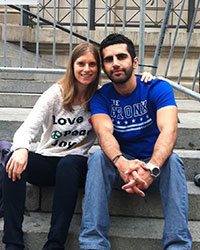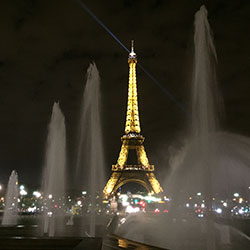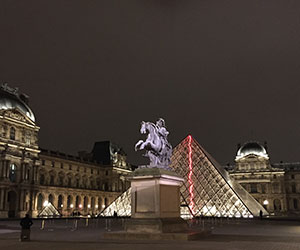

Medicine Through a Parisian Lens
Exchange Program in Paris Offers Insights into Medicine Abroad and at Home
Editor’s Note: This feature relates the experiences of Samim Atmar, M.D., class of 2015, during a medical education exchange program in Paris this past spring. When the events of November 13, 2015, occurred, Dr. Atmar’s first thoughts were of the many friends and colleagues he had met and worked with during his two-month stay. “Thanks to the ‘Safety Check’ page on Facebook, I was able to look up everyone and learn that they were safe,” he said. “That was a huge relief, although the events that day still sadden me and touched me deeply.”

Samim Atmar with French medical student Paulin Boucheron during her time in New YorkRecent Einstein graduate Samim Atmar remembers his final months as a medical student well. There were strolls along the Seine and al fresco dining on the Left Bank. And there was the time he had to restrain a delusional patient whose words he barely understood.
His two-month visit to Paris allowed him to complete an elective in psychiatry offered through Einstein’s student exchange program with the University of Paris. His study abroad followed a visit to Einstein by a French medical student, Pauline Boucheron, who took part in an epidemiology elective on the role of nutrition in chronic disease.
While Einstein boasts dozens of opportunities for students to travel abroad for clinical and research experience, the Paris program is one of four designated exchange programs that allow Einstein students to gain a global perspective on medicine, while refining their clinical skills in an environment that can pose unusual tests. (Other exchanges bring students to Israel, Japan, and Sweden.)
Before Paris, the soon-to-be minted physician had already faced some challenging international environments. Born in Kabul, Afghanistan, while the country was being rocked by civil war, he became a refugee at the age of 3. He and his family were forced to live in Pakistan, where they were “not invited” and frequently harassed, he recalled. Eventually, they sought and received asylum in the United States, 7,000 miles away.
Now in his first year of a residency in emergency medicine at Mount Sinai St Luke’s-Roosevelt Hospital in New York, his ultimate goal is to devote his medical skills to helping others who have been displaced from their homeland. Paris, the birthplace of humanitarian relief agency Medecins Sans Frontieres—or Doctors without Borders—seemed like a good place to start.
Despite studying Spanish in college and taking a crash course in French, Dr. Atmar quickly determined that his communication skills might not be sufficient for the fast pace of a French emergency department. “I was concerned about going into an ER… I wasn’t exactly fluent,” he said.
Instead, he chose a rotation on the inpatient child and adolescent psychiatric units of Hôpital Universitaire Pitié-Salpêtrière, a 1,600-bed teaching hospital in Paris’ 13th Arrondissement.

While in Paris, Samim visited many of its sights, including the Eiffel Tower...Unlike an ER, the rotation didn’t require split-second communication in a language that was foreign to him. But his communication barrier was often compounded by the limited communication ability of his patients, some of whom were dealing with autism spectrum disorders or could speak but were simply too young to express themselves verbally.
“A lot of what we’re taught as medical students is the importance of learning a patient’s history. That’s just a routine step in diagnosis,” Dr. Atmar said. “But what do you do if, for one reason or another, you can’t communicate vocally with your patient?”
To overcome that barrier, Dr. Atmar spoke more slowly, over-enunciating each word. For some patients, body language and hand gestures proved more effective. For younger patients, especially, he found crouching to be helpful, since it allowed him to communicate with them at eye level.
“There's really an art to dealing with such patients, especially when you don’t speak the same language. In addition to adapting to their social, communication and cognitive difficulties, I had to compensate for my own inadequate fluency with French,” he recalled.
A particular surprise for the physician-in-training was the relative lack of language translation services at Pitié-Salpêtrière, one of Europe’s largest and most well known medical centers. While such services are commonplace in New York hospitals, he said, “It was pretty much ‘French or nothing’ in Paris.”
The overseas experience was eye opening in other ways, too.
“I was intrigued to see how carefully a psychiatric diagnosis is made in France,” he said. “The clinicians there are adamant about not rushing to conclusions. Stamping a patient with a mental illness diagnosis is a major decision, and the French clinicians are very cautious about making sure they get to know the patient first.”

and the Louvre MuseumAt Pitié-Salpêtrière, plans for a patient’s treatment are made only after close consultation with a team of clinicians and with the patient’s family.
“Decisions are made with everyone together. There’s a sense of camaraderie, with everyone having a voice,” he added.
His time at the French hospital also served to demonstrate how healthcare providers make do with limited resources. Because private space is scarce at Pitié-Salpêtrière, clinicians resort to using room dividers when consulting with each other or a patient.
“What was most important was the patient,” he said.
Despite often-grueling days, Dr. Atmar managed to find some free time to enjoy Parisian cuisine and being surrounded by famed artifacts of history. “Walking the city streets is like traveling through an open-air museum,” he said.
Since returning to the U.S., he has already put the lessons he’s learned to good use. “It all begins with communication, with reading your patient, whether in a New York emergency room or a distant refugee camp,” he said. “In many respects, medicine is a language that is spoken the same way everywhere.”
Posted on: Monday, January 4, 2016

Tablet Blog